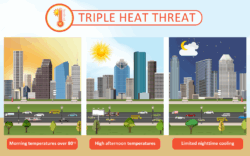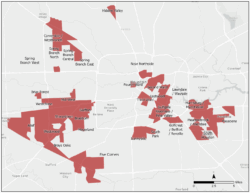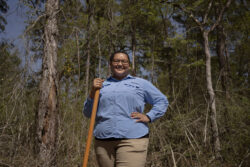

By Cateri Dixon, ForUsTree Environmental Education Intern, and Dr. Meredith Jennings, Director, Local Government & Community Initiatives
The 2024 H3AT Mapping Campaign results have given us a clearer picture of the differences in summer temperatures in under-resourced communities in The City of Houston and Harris County. Data from both Houston H3AT Mapping Campaigns (2020 and 2024) confirm a familiar pattern – not all communities are exposed to heat at the same level. The 2024 campaign findings specifically highlight which neighborhoods are facing the Triple Heat Threat, a set of three indicators used to identify communities with multiple signs of elevated heat conditions. The three indicators are morning temperatures above 80°F, a limited nighttime cooling capacity, and high afternoon temperatures.

Illustration of the three components of the Triple Heat Threat. Source: HARC
Heat Threat #1: Morning Temperatures Over 80°F
To avoid the hottest part of the day, you might wake up early to beat the intense heat and sunlight. However, in some areas, mornings may still offer little to no relief. When temperatures at 6–7 AM are already above 80°F, these communities may not experience cooler conditions until after sunset—if at all.
Heat Threat #2: Limited Nighttime Cooling
When night falls, people typically expect a much-needed drop in temperature after hours of sunlight. However, not all neighborhoods experience this cooling relief equally.
In Triple Heat Threat neighborhoods, nighttime temperatures drop by less than 9.4°F between sunset and sunrise—significantly less than the 12.2°F temperature drop seen in areas with the most cooling.
So, why do these neighborhoods remain hot at night? Where is the heat coming from?
This is a key effect of the urban heat island phenomenon. Man-made surfaces like concrete and asphalt absorb and store heat throughout the day, releasing it slowly even after the sun sets. As a result, these neighborhoods stay warmer for longer, limiting the night’s cooling benefits.
Heat Threat #3: High Afternoon Temperatures
The afternoon is typically considered the hottest part of the day, so many people avoid being outside when temperatures peak, or when the sun is at its highest, in the summer months.
Triple Heat Threat communities saw the hottest recorded afternoon temperatures (3–4 PM) on H3AT Mapping Campaign Day. One such area, the Hidden Valley neighborhood located near the intersection of I-45 and 249, recorded a scorching 103°F, which ended up being the highest observed afternoon temperature on Campaign Day last August.
Communities Facing the Triple Heat Threat
Harris County communities in the southwest (between Gulfton and Alief), northwest (between Jersey Village and Spring Branch East), and central to southeast regions all checked the three boxes of the Triple Heat Threat.

The Campaign showed us that one of the largest continuous Triple Heat Threat areas is in southwest Houston, which includes the neighborhoods of Gulfton, Alief, Sharpstown, Westwood, and Mid West. Source: HARC
Taken alone, each of these three heat threats could already increase the risk of heat-related illness. But combine these together, and they create a taxing burden on our most vulnerable community members; this includes children, the elderly, people with disabilities, those with preexisting conditions, and those who work outdoors. Nearly 1.3 million Houstonians live in Triple Heat Threat areas (2022 American Community Survey). Within these areas, 48% of the population is low income and 9% of the population does not own or have access to a vehicle, which may result in greater reliance on public transportation or walking to destinations in hot summer months. Dehydration, heat exhaustion, and heat stroke can occur when people are exposed to extreme heat. Homes in low-income areas, that are older or lack insulation can be financially burdened by the costs of using and maintaining air conditioning units.
Mitigating the Triple Heat Threat: Planting the Solution
Satellite imagery of Triple Heat Threat areas reveals that these neighborhoods have more concrete and asphalt, with sparse natural green space. When the sun beats down on heat-trapping surfaces like concrete sidewalks and parking lots, these materials absorb and retain heat, making the surrounding area hotter.
But what if the pavement wasn’t directly exposed to sunlight? What if something cool—like trees—provided shade? Even though it’s still wise to avoid being outside during the hottest parts of the day, shaded and vegetated areas can make summer conditions more comfortable. In fact, research shows that tree cover can cool an area by up to 10°F (Ziter et al., 2019). Other cooling strategies include cool pavements, green roofs, and native prairie plantings, each with its own set of benefits.
The ForUsTree initiative led by HARC consists of multiple locally led reforestation and tree planting projects and educational activities to be collaboratively implemented within Houston and Harris County. The expected accomplishments include planting or giving away at least 54,310 trees of varying sizes and species. These trees will help provide much needed shade and other benefits for under-resourced communities in our region. The full benefits of these activities will be tracked at www.forustreehtx.org
In the U.S., heat waves are the deadliest type of extreme weather event. Reducing the impacts of extreme heat exposure is essential to protecting our most vulnerable populations in Houston, which is why we created these heat maps. By identifying which neighborhoods face the Triple Heat Threat, education and resources can be provided to help our more vulnerable community members. Even in the face of rising extreme heat, planting trees and embracing green initiatives can cool our cities, restore balance to our climate, and grow a future where everyone can thrive.

Cateri Dixon, ForUsTree Environmental Education Intern Source: SCA
For More Information
To learn more about these initiatives, visit www.h3at.org or forustreehtx.org
Acknowledgements
Funding for these projects provided by the USDA Forest Service, Urban and Community Forestry Program.
HARC is an equal opportunity provider.